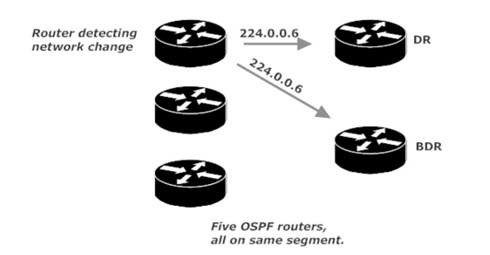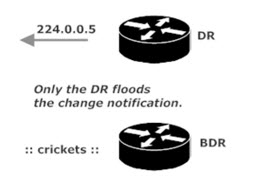CCNA 200-301 Bulldog Practice Exam: The OSPF DR And BDR
Today’s new CCNA 200-301 practice exam is all about the OSPF Designated Router (DR) and Backup Designated Router (BDR). Let’s get right to it!
More CCNA 200-301 Practice Exams
CCNA Command Reference: ip domain-lookup (video and text!)
Question 1:
The DR and BDR of a broadcast segment have learned of a topology change in the network. Which router(s) will flood news of the change to the rest of the segment?
A. The DR only.
B. The BDR only.
C. Both the DR and BDR.
D. Neither the Designated Router nor the Backup Designated Router perform this action on an OSPF broadcast segment.
Question 2:
Which router on this OSPF broadcast segment will become the Designated Router?

Question 3:
In that same network, what is the OSPF RID of R1?
Question 4:
You just used the router-id command to change the OSPF Router ID of a Cisco router. What must you do now in order for that change to take effect?
A. As with most Cisco commands, you don’t have to do anything.
B. Save the configuration.
C. Either reload the router or clear the OSPF process.
D. Run the ospf reset command.
Question 5:
Which of these OSPF network types will not elect a DR nor a BDR? Choose all that apply.
A. Broadcast
B. Point-to-point
C. Point-to-multipoint
D. NBMA
And now… the answers!
Okay, NOW the answers! Those are great links, though!
Answer 1: A. While both the DR and BDR are notified of such a change via 224.0.0.6…

… only the DR sends the change notification to 224.0.0.5, the All-OSPF-Routers reserved multicast address.

Answer 2: R4 will become the DR due to its OSPF RID of 172.1.1.4. The router with the highest RID will become the DR for that particular segment.
Answer 3: The RID of R1 is 1.1.1.1, even if R1’s Loopback interface isn’t OSPF-enabled. The RID will always be the highest IP address on a loopback interface on a router. If there isn’t a loopback on the router, the highest IP address on a physical interface will be the OSPF RID. In either case, it doesn’t matter whether the interface is actually OSPF-enabled.
Answer 4: C. Most Cisco router and switch commands take effect immediately, but this is one of those exceptions. When you change the OSPF RID on a Cisco device, you must either reload the device or use the clear ip ospf process command to — what else? — clear the OSPF process.
Answer 5: B, C. Neither the point-to-point nor the point-to-multipoint OSPF network types elect a DR or BDR. While you won’t be responsible for configuring a point-to-multipoint network on your CCNA exam, it’s a good idea to know that particular fact about that particular network.
Thanks for taking this CCNA Bulldog Practice Exam! Just click that link to access dozens of other free exams here on the site, and I’ll see you tomorrow with another free exam.
Chris Bryant
CCIE #12933
“The Computer Certification Bulldog”




